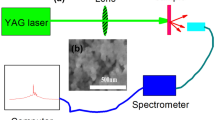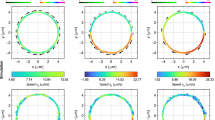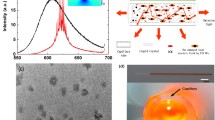Abstract
In this paper, we introduce a novel approach to control the random lasing based on multiphoton luminiscence in Zinc oxide (ZnO) nanoparticle water suspension during its guided freezing process. The freezing process leads to the formation of a particle layer on the ice surface, consequently reducing the photon’s scattering mean free path in the medium, as well as increase in the efficiency of the second harmonic generation. This results in a lowered random lasing threshold in the system. The post freezing threshold, under the 355 nm wavelength excitation, decreases by an order of magnitude. These effects may have several applications, including the phase transition sensing, monitoring the evolution of porous structures via the ice-templating technique, controlling the random lasing mode, and enhancing various nonlinear optical processes’ effectiveness for nanoparticles and sub-micron particles in suspensions.
Similar content being viewed by others
References
Ü. Özgür, Ya. I. Alivov, C. Liu, et al., J. Appl. Phys., 98, 041301 (2005); https://doi.org/10.1063/1.1992666
P. Y. Yu and M. Cardona, Fundamentals of Semiconductors, Springer (1999); https://doi.org/10.1007/978-3-662-03848-2
F. Rahman, Opt. Eng., 58, 010901 (2019); https://doi.org/10.1117/1.oe.58.1.010901
R. Könenkamp, R. C. Word, and C. Schlegel, Appl. Phys. Lett., 85, 6004 (2004); https://doi.org/10.1063/1.1836873
R. Sha, A. Basak, P. C. Maity, and S. Badhulika, Sens. Actuator. Rep., 4, 100098 (2022); https://doi.org/10.1016/j.snr.2022.100098
B. Ortiz-Casas, A. Galdámez-Martínez, J. Gutiŕrez-Flores, et al., Mater. Today, 50, 553 (2021); https://doi.org/10.1016/j.mattod.2021.07.025
A. Wibowo, M. A. Marsudi, M. I. Amal, et al., RSC Adv., 10, 42838 (2020); https://doi.org/10.1039/d0ra07689a
D. S. Wiersma, Nat. Phys., 4, 359 (2008).
B. Redding, M. A. Choma, and H. Cao, Nat. Photonics, 6, 355 (2012); https://doi.org/10.1038/nphoton.2012.90
V. S. Letokhov, Sov. Phys. JETP, 26, 835 (1967).
E. K. Kazakova, A. V. Kraiskii, V. A. Zubov, et al., Bull. Lebedev Phys. Inst., 7, 42 (1970) [in Russian].
V. A. Zubov, G. V. Peregudov, M. M. Sushchinskii, et al., Sov. J. Exp. Theor. Phys. Lett., 5, 188 (1967).
G. V. Peregudov, E. N. Ragozin, and V. A. Chirkov, Sov. J. Exp. Theor. Phys., 63, 421 (1972).
V. M. Markushev, V. F. Zolin, and Ch. M. Briskina, Sov. J. Quantum Electron., 13, 427 (1986).
M. S. Steinberg, E. Sondheimer, A. H. Wilson, et al., Phys. Rev., 109, 1492 (1958); https://doi.org/10.1103/PhysRev.109.1492
D. S. Wiersma, P. Bartolini, A. Lagendijk, and R. Righini, Nature, 390, 671 (1997); https://doi.org/10.1038/37757
H. Cao, J. Y. Xu, Y. Ling, et al., IEEE J. Sel. Top. Quantum Electron., 9, 111 (2003); https://doi.org/10.1109/JSTQE.2002.807975
R. Sapienza, Nat. Rev. Phys., 1, 690 (2019); https://doi.org/10.1038/s42254-019-0113-8
H. Cao, Y. G. Zhao, S. T. Ho, et al., Phys. Rev. Lett., 82, 2278 (1999); https://doi.org/10.1103/PhysRevLett.82.2278
L. Fedorenko, V. Litovchenko, V. Naumov, et al., Coatings, 12, 1705 (2022); https://doi.org/10.3390/coatings12111705
A. C. Vutha, S. K. Tiwari, and R. K. Thareja, J. Appl. Phys., 99, 123509 (2006); https://doi.org/10.1063/1.2206608
H. Jiu and L. Zhang, J. Rare Earths, 27, 786 (2009); https://doi.org/10.1016/S1002-0721(08)60335-X
P. N. Prasad, Introduction to Biophotonics, Wiley (2003); https://doi.org/10.1002/0471465380
D. A. Parthenopoulos and P. M. Rentzepis, Science, 245, 843 (1989); https://doi.org/10.1126/science.245.4920.843
M. Albota, D. Beljonne, J. L. Brédas, et al., Science, 281, 1653 (1998); https://doi.org/10.1126/science.281.5383.1653
J. Tian, G. Weng, Y. Wang, et al., ACS Appl. Nano Mater., 2, 1909 (2019); https://doi.org/10.1021/acsanm.8b02300
C. M. Soukoulis, X. Jiang, J. Y. Xu, and H. Cao, Phys. Rev. B, 65, 041103(R) (2002); https://doi.org/10.1103/PhysRevB.65.041103
T. Sun, Z. R. Qiu, H. M. Su, et al., Appl. Phys. Lett., 91, 241110 (2007); https://doi.org/10.1063/1.2824395
T. Naruta, T. Akita, Y. Uchida, et al., Opt. Express, 27, 24426 (2019); https://doi.org/10.1364/oe.27.024426
M. Trivedi, D. Saxena, W. K. Ng, et al., Nat. Phys., 18, 939 (2022); https://doi.org/10.1038/s41567-022-01656-2
J. You, J. Wang, L. Wang, et al., Colloids Surf. A Physicochem. Eng. Asp., 531, 93 (2017); https://doi.org/10.1016/j.colsurfa.2017.07.073
G. Shao, D. A. H. Hanaor, X. Shen, and A. Gurlo, Adv. Mater., 32, 1907176 (2020); https://doi.org/10.1002/adma.201907176
A. A. Matrokhin, M. A. Shevchenko, S. F. Umanskaya, et al., Photonics, 9, 705 (2022); https://doi.org/10.3390/photonics9100705
J. M. Hvam, Solid State Commun., 12, 95 (1973); https://doi.org/10.1016/0038-1098(73)90513-9
J. M. Hvam, Phys. Status Solidi B Basic Res., 63, 511 (1974); https://doi.org/10.1002/pssb.2220630210
C. Klingshirn, Phys. Status Solidi B Basic Res., 71, 547 (1975); https://doi.org/10.1002/pssb.2220710216
B. Hönerlage, C. Klingshirn, and J. B. Grun, Phys. Status Solidi B Basic Res., 78, 599 (1976); https://doi.org/10.1002/pssb.2220780219
H. Haug and S. Koch, Phys. Status Solidi B Basic Res., 82, 531 (1977); https://doi.org/10.1002/pssb.2220820216
C. Klingshirn and H. Haug, Phys. Rep., 70, 315 (1981); https://doi.org/10.1016/0370-1573(81)90190-3
R. Matsuzaki, H. Soma, K. Fukuoka, et al., Phys. Rev. B, 96, 125306 (2017); https://doi.org/10.1103/PhysRevB.96.125306
J. Dai, C. X. Xu, P. Wu, at al., Appl. Phys. Lett., 97, 011101 (2010); https://doi.org/10.1063/1.3460281
S. H. Lee, T. Goto, H. Miyazaki, and T. Yao, Opt. Lett., 38, 2413 (2013).
Y. Rho, S. J. Yoo, D. B. Durham, at al., Nano Lett., 23, 1843 (2023); https://doi.org/10.1021/acs.nanolett.2c04748
M. A. Shevchenko, S. F. Umanskaya, S. D. Abdurakhmonov, et al., Bull. Lebedev Phys. Inst., 49, 55 (2022); https://doi.org/10.3103/S1068335622020075
P. W. Anderson, Philos. Mag. B, 52, 505 (1985); https://doi.org/10.1080/13642818508240619
Author information
Authors and Affiliations
Corresponding author
Rights and permissions
Springer Nature or its licensor (e.g. a society or other partner) holds exclusive rights to this article under a publishing agreement with the author(s) or other rightsholder(s); author self-archiving of the accepted manuscript version of this article is solely governed by the terms of such publishing agreement and applicable law.
About this article
Cite this article
Umanskaya, S.F., Shevchenko, M.A., Tcherniega, N.V. et al. Tuning the efficiency of Random Laser Generation in a Suspension of ZnO Nanoparticles by Means of its Directional Freezing. J Russ Laser Res 44, 691–699 (2023). https://doi.org/10.1007/s10946-023-10179-x
Received:
Published:
Issue Date:
DOI: https://doi.org/10.1007/s10946-023-10179-x




